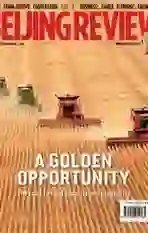Agricultural Development:A Shining Star
2018-11-09
Once again, Chinas annual autumn grain output exceeded 600 billion kg. That is enough even for a country of nearly 1.4 billion people to be self-sufficient. This is the sixth consecutive year that China has registered a grain output of over 600 billion kg.
During an inspection tour of northeast Chinas Heilongjiang Province in September, President Xi Jinping said that Chinese people should fi ll their bowls with their own grain.
A self-reliant food supply has long been the goal of the Chinese Government and the people. Since the reform and opening-up policy was introduced in 1978, Chinas grain output has been continuously improving, not only ensuring the survival of the large population but also making peoples diet increasingly diverse.
Heilongjiang has made an extraordinary contribution to Chinas food security, with its grain production and sales ranking fi rst in the country for seven consecutive years. As this year marks the 40th anniversary of the implementation of the reform and opening up, Beijing Review reporters traveled to Heilongjiang to witness and record the provinces achievement in agricultural development. They discovered that the province has become an exemplar of Chinas agricultural modernization.
Food security, agriculture and the development of rural society are crucial issues for China. Those living in rural areas account for the majority of Chinas vast population. A strengthened agricultural sector is key for China to become a stronger nation with agricultural modernization.
After 40 years of reform and opening up, Chinas agricultural modernization has developed signifi cantly, with staple food grain, meat and eggs in ample supply. The quality and safety of agricultural products is also steadily improving and the mechanization of production has been advanced.
An agricultural industry underpinned by modern equipment and advanced technology has come into being.
Heilongjiang has taken the lead in agricultural modernization and plays an important role in ensuring grain security for the country. The economically developed coastal areas in eastern China, suburban areas of large cities and some additional localities have also realized agricultural modernization.
However, due to Chinas immense territory, agricultural development levels vary between places. Most rural areas are still restricted by natural conditions. Chinas agricultural sector faces many problems. Increasing labor and land costs and competition from foreign products are just two of them. The amount of agricultural imports has increased year by year since China joined the World Trade Organization in 2001.
The only way to solve the problem lies in learning from the experiences of Heilongjiang to promote agricultural modernization and strengthen the agricultural industry as a whole.
